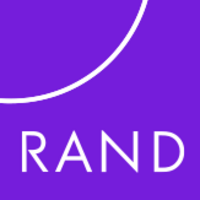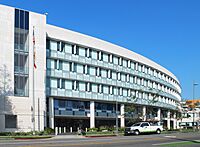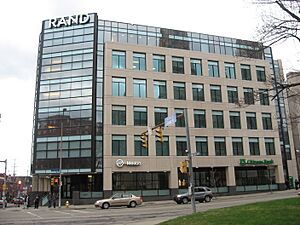RAND Corporation facts for kids
 
Headquarters in Santa Monica, California
|
|
| Predecessor | Started as Project RAND, a team-up between Douglas Aircraft Company and the United States Air Force. It later became an independent nonprofit group. |
|---|---|
| Formation | May 14, 1948 |
| Founders |
|
| Type | An organization that studies big problems and advises governments |
| Legal status | Nonprofit corporation |
| Purpose |
|
| Headquarters | Santa Monica, California, U.S. |
|
Region
|
Worldwide |
|
President and CEO
|
Jason Gaverick Matheny |
|
RAND Leadership
|
|
|
President, RAND Europe
|
Hans Pung |
|
|
| Subsidiaries | RAND Europe Frederick S. Pardee RAND Graduate School |
| Affiliations | Independent |
|
Revenue
|
|
| Disbursements | Numerous |
| Expenses | |
| Endowment | $288.7 million (2023) |
|
Staff
|
1,900 (2023) |
The RAND Corporation is an American non-profit organization that researches important issues and gives advice to leaders and governments. Think of it as a "think tank," a place where experts study big problems and come up with solutions. The name RAND comes from the words "research and development."
Since the 1950s, RAND's research has helped shape major U.S. decisions. This includes work on the Cold War space race, the creation of social programs, and ideas about national health care.
RAND started as "Project RAND" right after World War II. The U.S. Army Air Forces wanted a group to think about future weapons and defense. At first, it was a partnership with the Douglas Aircraft Company. Later, it became its own independent organization.
Today, RAND studies a wide range of topics, not just military ones. It gets money from the U.S. government, private companies, universities, and other groups to fund its research.
Contents
What is the RAND Corporation?
RAND has about 1,900 employees working in offices around the world. Its main office, or headquarters, is in Santa Monica, California. It also has offices in other U.S. cities like Arlington, Virginia, and Pittsburgh, Pennsylvania. RAND even has branches in Europe and Australia.
RAND is also home to a special graduate school, the RAND School of Public Policy. It was one of the first schools to offer a Ph.D. (the highest university degree) in public policy. Students at the school learn to solve real-world problems by working with RAND's expert researchers.
Many smart people have worked with RAND. Over 30 people who have won the Nobel Prize, a very high honor, have been connected to the organization.
History of RAND
Project RAND: The Beginning
After World War II, leaders in the U.S. military and government were worried. They didn't want to lose the amazing scientific talent that had helped win the war. In 1945, General Henry "Hap" Arnold of the U.S. Army Air Forces had an idea. He wanted to create a private group to continue important research for the country's future.
He teamed up with Donald Wills Douglas, Sr., the head of the Douglas Aircraft Company, and an engineer named Franklin R. Collbohm. They created "Project RAND" to focus on long-term planning for the military. One of its first big ideas, released in 1946, was a report about designing a spaceship that could circle the Earth. This was more than ten years before the first satellite was launched!
Becoming an Independent Organization
By 1948, the leaders of Douglas Aircraft felt that being so close to Project RAND could cause problems. They worried it might seem unfair when they tried to get government contracts to build new planes.
So, the U.S. Air Force agreed to let Project RAND become its own independent, non-profit organization. On May 14, 1948, the RAND Corporation was officially created. It was no longer part of the Douglas company. The Ford Foundation, a major charity, provided money to help it get started.
RAND became known as the first modern "think tank." It created a model for how experts could study problems and give independent advice to help leaders make better decisions.
What Does RAND Research?

RAND is famous for developing a method called systems analysis. This is a way of looking at all parts of a complex problem to find the best solution. This method has been used in many important areas.
RAND researchers helped develop ideas that were used to build the Internet. They also made important contributions to the U.S. space program and the field of artificial intelligence.
Today, RAND studies many different subjects to help improve people's lives and keep them safe.
Defense and National Security
During the Cold War, RAND helped develop the U.S. strategy for dealing with nuclear weapons. More recently, it has studied how to best prepare the military and fight terrorism. For example, RAND looked at military operations in Iraq and Afghanistan to see what worked and what didn't.
Health and Safety
RAND has done a lot of research on health. From 1974 to 1982, it ran a major study on health insurance to see how costs affect people's decisions about their health care.
More recently, RAND started a project to study gun policies in America. Researchers looked at thousands of studies to find out which laws have been shown to work. For example, they found evidence that laws preventing children from accessing guns reduce injuries. They also share what is not yet known, to show where more research is needed.
Education
RAND also looks at how to improve schools. In one major study, it looked at a program funded by the Gates Foundation that was meant to make teachers more effective. The study found that the program did not have a major effect on how well students did in school. This kind of honest feedback helps organizations decide how to spend their money to make a real difference.
Famous People Connected to RAND
Many well-known people have worked at or with RAND over the years. Here are a few of them:
- Henry H. "Hap" Arnold: A top general in the U.S. Air Force and one of RAND's founders.
- Kenneth Arrow: An economist who won the Nobel Prize.
- Paul Baran: An engineer who helped develop packet switching, a key technology for the Internet.
- Daniel Ellsberg: An economist who worked at RAND and later became famous for releasing the Pentagon Papers.
- Francis Fukuyama: A famous writer and expert on politics.
- Herman Kahn: A strategist who thought about nuclear war. His work was famously parodied in the movie Dr. Strangelove.
- Henry Kissinger: A former U.S. Secretary of State and Nobel Peace Prize winner.
- John Forbes Nash, Jr.: A mathematician and Nobel Prize winner whose life was shown in the movie A Beautiful Mind.
- John von Neumann: A brilliant mathematician who was a key figure in the development of the modern computer.
- Condoleezza Rice: A former U.S. Secretary of State.
- Donald Rumsfeld: A former U.S. Secretary of Defense who also served as chairman of RAND's board.
- Thomas C. Schelling: An economist who won the Nobel Prize for his work on conflict and strategy.
See also
 In Spanish: RAND para niños
In Spanish: RAND para niños
- A Million Random Digits with 100,000 Normal Deviates (a book of random numbers published by RAND)
- Truth Decay (a book by RAND about the challenges of facts in modern life)

